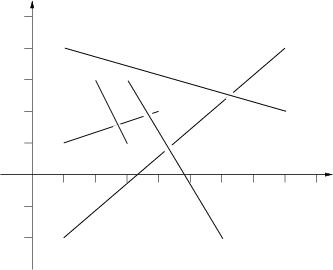POJ2653(Pick-up sticks)(线段相交问题)
2016-01-12 14:32
501 查看
Pick-up sticks
Description
Stan has n sticks of various length. He throws them one at a time on the floor in a random way. After finishing throwing, Stan tries to find the top sticks, that is these sticks such that there is no stick on top of them. Stan has noticed that the last thrown
stick is always on top but he wants to know all the sticks that are on top. Stan sticks are very, very thin such that their thickness can be neglected.
Input
Input consists of a number of cases. The data for each case start with 1 <= n <= 100000, the number of sticks for this case. The following n lines contain four numbers each, these numbers are the planar coordinates of the endpoints of one stick. The sticks
are listed in the order in which Stan has thrown them. You may assume that there are no more than 1000 top sticks. The input is ended by the case with n=0. This case should not be processed.
Output
For each input case, print one line of output listing the top sticks in the format given in the sample. The top sticks should be listed in order in which they were thrown.
The picture to the right below illustrates the first case from input.

Sample Input
Sample Output
Hint
Huge input,scanf is recommended.
题意:给你一些线段,将那些未被压到的线段输出~
其实还是判断线段是否相交的问题。
| Time Limit: 3000MS | Memory Limit: 65536K | |
| Total Submissions: 11507 | Accepted: 4322 |
Stan has n sticks of various length. He throws them one at a time on the floor in a random way. After finishing throwing, Stan tries to find the top sticks, that is these sticks such that there is no stick on top of them. Stan has noticed that the last thrown
stick is always on top but he wants to know all the sticks that are on top. Stan sticks are very, very thin such that their thickness can be neglected.
Input
Input consists of a number of cases. The data for each case start with 1 <= n <= 100000, the number of sticks for this case. The following n lines contain four numbers each, these numbers are the planar coordinates of the endpoints of one stick. The sticks
are listed in the order in which Stan has thrown them. You may assume that there are no more than 1000 top sticks. The input is ended by the case with n=0. This case should not be processed.
Output
For each input case, print one line of output listing the top sticks in the format given in the sample. The top sticks should be listed in order in which they were thrown.
The picture to the right below illustrates the first case from input.

Sample Input
5 1 1 4 2 2 3 3 1 1 -2.0 8 4 1 4 8 2 3 3 6 -2.0 3 0 0 1 1 1 0 2 1 2 0 3 1 0
Sample Output
Top sticks: 2, 4, 5. Top sticks: 1, 2, 3.
Hint
Huge input,scanf is recommended.
题意:给你一些线段,将那些未被压到的线段输出~
其实还是判断线段是否相交的问题。
#include<stdio.h>
#include<algorithm>
using namespace std;
struct node
{
double x,y;
};
struct st
{
node a,b;
}data[100010];
int judge(int i,int j)
{
if(min(data[i].a.x,data[i].b.x)>max(data[j].a.x,data[j].b.x))
return 0;
if(min(data[i].a.y,data[i].b.y)>max(data[j].a.y,data[j].b.y))
return 0;
if(min(data[j].a.x,data[j].b.x)>max(data[i].a.x,data[i].b.x))
return 0;
if(min(data[j].a.y,data[j].b.y)>max(data[i].a.y,data[i].b.y))
return 0;
double h=(data[i].a.x-data[j].a.x)*(data[j].b.y-data[j].a.y)-(data[i].a.y-data[j].a.y)*(data[j].b.x-data[j].a.x);
double k=(data[i].b.x-data[j].a.x)*(data[j].b.y-data[j].a.y)-(data[i].b.y-data[j].a.y)*(data[j].b.x-data[j].a.x);
double m=(data[j].a.x-data[i].a.x)*(data[i].b.y-data[i].a.y)-(data[j].a.y-data[i].a.y)*(data[i].b.x-data[i].a.x);
double n=(data[j].b.x-data[i].a.x)*(data[i].b.y-data[i].a.y)-(data[j].b.y-data[i].a.y)*(data[i].b.x-data[i].a.x);
return h*k<=0&&m*n<=0;
}
int main()
{
int n,j;
while(scanf("%d",&n),n)
{
for(int i=1;i<=n;i++)
scanf("%lf%lf%lf%lf",&data[i].a.x,&data[i].a.y,&data[i].b.x,&data[i].b.y);
printf("Top sticks: ");
for(int i=1;i<n;i++)
{
for(j=i+1;j<=n;j++)
{
if(judge(i,j))
break;
}
if(j==n+1)
printf("%d, ",i);
}
printf("%d.\n",n);
}
}
相关文章推荐
- 安卓滚动数字的实现(从0开始增加到指定数字)
- Bmob用户功能详解(三)
- 【看书】关于for循环中定义变量的后续讨论
- PAT_B_1015. 德才论 (25) or PAT_A_1062. Talent and Virtue (25)
- UITableViewCell重影问题
- 苦逼也聊模式--(0)--开篇
- 【Linux命令】mysql数据库常用操作命令
- Maven多模块项目 eclipse暖部署 Maven项目实现 tomcat热部署
- iOS网络请求NSURLSession
- Atom 编辑器的使用
- 关于 Hibernate 级联操作
- laravel5中间件的使用例子
- 黄聪:WordPress 备案期间临时关闭站点设置404
- 开始学nodejs——net模块
- ios获取设备信息总结
- IOS生成与读取二维码名片
- repeater嵌套
- 词自动纠错
- 电子商务行业数据集成案例介绍
- 岗位 人员 职位 机构之间的关系
